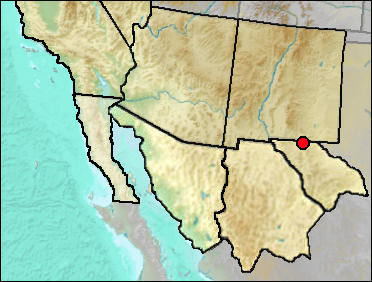 Age. Late Wisconsin (see dates below).
Age. Late Wisconsin (see dates below).
Description. One of three caves (the Upper Sloth Cave (C-08), Lower Sloth Cave (C-05), and Dust Cave (C-09) located at the base of cliffs of Permian limestone in Guadalupe Mountains National Park (Van Devender et al. 1977). Mera (1938:35) described the cave as having "an extreme depth of a hundred and fifteen feet; at the point of greatest width it measured forty-five feet, and varied from six to ten feet in height."
Discussion. C-08, under the name High Cave, was excavated in 1931 as part of an archaeological program of the Laboratory of Anthropology (Mera 1938). It later was tested by Logan in 1974 for fossil vertebrates (Logan and Black 1979). The present vegetation is a mixture of Chihuahuan desertscrub with some woodland species. Colorado pinyon (Pinus edulis) grows in favored localities elevationally above and below the cave, though not in the immediate vicinity (Van Devender et al. 1977).
Van Devender et al. recovered two samples of plant remains. One came from a packrat midden in a crevice above the entrance and is radiocarbon dated at 13,060 ± 280 BP (A-1549). The midden vegetation includes elements of mixed coniferous forest, including spruce (Picea sp.), Limber Pine (Pinus flexilis), Colorado Pinyon (Pinus edulis), Douglas Fir (Pseudotsuga menziesii), and Dwarf Juniper (Juniperus communis). The nearest spruce today is in the Sacramento Mountains, and Common Juniper occurs no closer than the southern end of the Rocky Mountains in northern New Mexico.
The second sample was from unconsolidated material from a shallow pit dug by Logan (Trench 1) near the front of the cave. Stratigraphy consisted of an upper archaeological layer (Unit 1 of Logan), a layer with sloth dung, a layer of wood, and a layer of leaves and organic material (from which the plant sample was taken). A date on artiodactyl dung from the sloth layer is 11,760 ± 610 BP (A-1533). The plants from the sample indicate an intermediate vegetation between the high-elevation coniferous forest and the present upper desert vegetation.
Logan (Logan and Black 1979) excavated two trenches in the front part of the cave. Trench 1 was radiocarbon dated at the 30-40 cm level at 11,760 ± 610. Dates are not available for Trench 2; Logan and Black note that the only correlation with Trench 1 is the presence of Cryptotis parva and Sorex cinereus in the 30-40 cm level of Trench 1 and the 10-20 cm level of Trench II. Most of the fossil material came from Trench 2, with Nothrotheriops dung and the two species of shrew recorded as from Trench 1. Logan gives occurrences by level, but the entire fauna is given here as a single unit.
Logan and Black (1979) recorded the Desert Shrew (Notiosorex crawfordi), but in an extensive study, Carraway (2010) found no Pleistocene (or Holocene) fossils of this species, all examined specimens belonging to one of two new species (N. dalquesti and N. harrisi). Specimens from this site were not examined and, from personal examination, likely are unidentifiable to species. In light of this, Logan and Black's identification is changed to Notiosorex sp.
Reexamination of the shrew and Neotoma material was undertaken during the Dust Cave project (Harris and Hearst 2012). Presence of Cryptotis parva could not be confirmed, and teeth identified as Neotoma mexicana could belong to either N. mexicana or N. cinerea. However, identification of Sorex cinereus was validated.
Fauna.
Reptilia
Sceloporus poinsettii—Crevice Spiny Lizard (Logan and Black 1979)
Sceloporus cowlesi—Southern Plateau Lizard (Logan and Black 1979)
Urosaurus ornatus—Tree Lizard (Logan and Black 1979)
Plestiodon sp.—Skink (Logan and Black 1979)
Plestiodon multivirgatus—Many-lined Skink (Logan and Black 1979)
Arizona elegans—Glossy Snake (Logan and Black 1979)
Bogertophis subocularis—Trans-Pecos Rat Snake (Logan and Black 1979)
Coluber/Masticophis—Racer/Coachwhip (Logan and Black 1979)
Liochlorophis vernalis—Rough Green Snake (Logan and Black 1979)
Salvadora sp.—Patch-nose Snake (Logan and Black 1979: cf.)
Trimorphodon vilkinsonii —Chihuahuan Lyre Snake (Logan and Black
1979)
Crotalus sp.—Rattlesnake (Logan and Black 1979)
Diadophis punctatus—Ringneck Snake
Thamnophis sp.—Garter Snake (Logan and Black 1979)
Mammalia
Nothrotheriops shastensis—Shasta Ground Sloth (Logan and Black
1979)
Marmota flaviventris—Yellow-bellied Marmot (Logan and Black 1979)
Otospermophilus variegatus—Rock Squirrel (Logan and Black 1979)
Cratogeomys castanops—Yellow-faced Pocket Gopher (Logan and Black
1979)
Thomomys bottae—Botta's Pocket Gopher (Logan and Black 1979)
Microtus mogollonensis—Mogollon Vole (Logan and Black 1979)
Neotoma cinerea—Bushy-tailed Woodrat (Logan and Black 1979)
Neotoma leucodon—White-toothed Woodrat (Logan and Black 1979)
Neotoma mexicana—Mexican Woodrat (Logan and Black 1979)
Neotoma micropus—Southern-Plains Woodrat (Logan and Black 1979)
Peromyscus eremicus—Cactus Mouse (Logan and Black 1979)
Lepus sp.—Jackrabbit (Logan and Black 1979)
Sylvilagus sp.—Cottontail (Logan and Black 1979)
Cryptotis parva—Least Shrew (Logan and Black 1979); Identification unconfirmed (Harris and Hearst 2012)
Notiosorex sp.—Notiosorex Shrew (Logan and Black 1979)
Sorex cinereus—Masked Shrew (Logan and Black 1979)
Antrozous pallidus—Pallid Bat (Logan and Black 1979)
Corynorhinus townsendii—Townsend's Big-eared Bat (Logan and Black
1979)
Eptesicus fuscus—Big Brown Bat (Logan and Black 1979)
Lasionycteris noctivagans—Silver-haired Bat (Logan and Black 1979)
Myotis velifer—Cave Myotis (Logan and Black 1979)
Puma concolor—Mountain Lion (Logan and Black 1979)
Mustela frenata—Long-tailed Weasel (Logan and Black 1979)
Bassariscus astutus—Ringtail (Logan and Black 1979)
Literature. Carraway 2010; Harris and Hearst 2012; Logan and Black 1979; Mera 1938; Van Devender et al. 1977.
Last Update: 15 Jan 2013